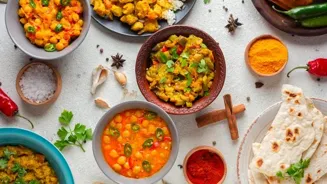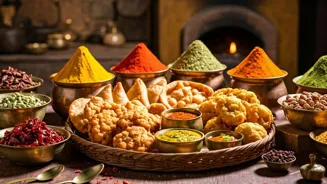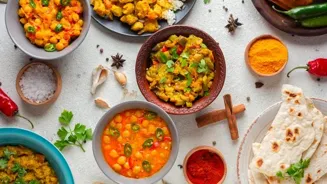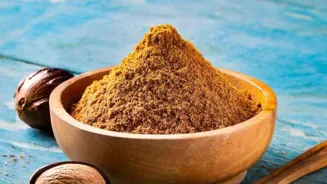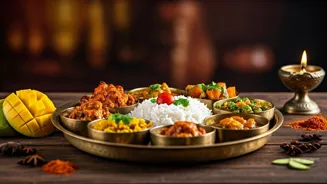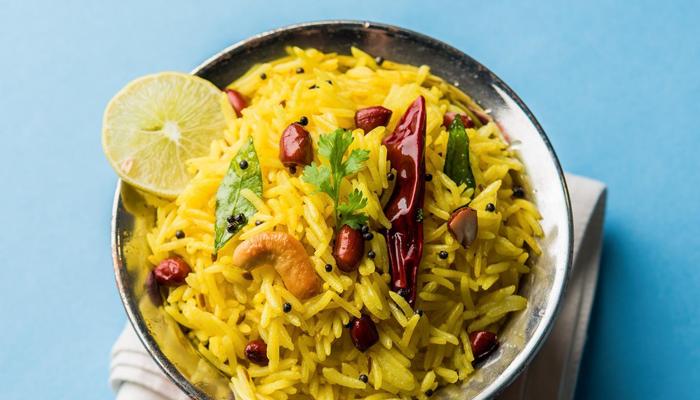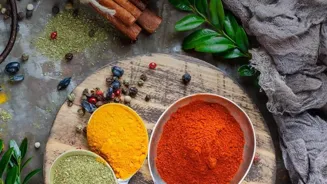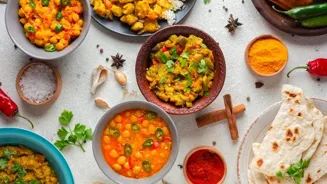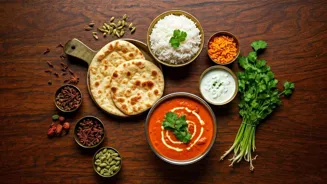Unlock the Secrets of Hosting an Indian Feast: Tips for Menu Planning and Preparation! Dive in for a culinary adventure!
Diwali around the corner? Wedding bells ringing? Or simply feeling like treating
your loved ones to a culinary masterpiece? Hosting an Indian feast can seem daunting, but with careful planning and a dash of enthusiasm, you can create an unforgettable dining experience.
Forget ordering in – let’s unlock the secrets to a vibrant, vegetarian Indian spread, right in your own kitchen!
Tips for creating a well-balanced Indian meal
First things first, let’s conquer the menu. A well-balanced Indian meal is all about harmonious flavours and diverse textures. Think about the season. If it’s summer, focus on lighter, cooling dishes. Winter calls for richer, warming options.
Consider your guests' spice preferences – some might enjoy a fiery punch, while others prefer a milder touch. Aim for a mix of dry and gravy-based dishes, something fried, something fresh, and definitely something sweet to round it all off.
Vegetarian starters set the scene for a great Indian meal
Vegetarian starters are aplenty and can make use of classic options. Samosas with a tamarind chutney are always crowd-pleasers. Their flaky crust and spicy potato filling are irresistible.
Another great option is vegetable pakoras – crispy fritters made with chickpea flour and an assortment of vegetables like onions, spinach, and potatoes. Serve with a mint-coriander chutney for a refreshing contrast. For a lighter touch, try dahi puri.
These small, crispy shells are filled with potatoes, chickpeas, yogurt, and chutneys, offering a burst of flavours and textures in every bite. Don’t forget the pani puri – a true street food sensation.
Serve the tangy, spiced water separately and let your guests assemble their own bite-sized delights. Your choices of starters are really what sets the scene for a great Indian meal.
Impress with Dal Makhani, Baingan Bharta, Aloo Gobi, and Paneer Butter Masala
Now, let's talk about the main course, and this is where you really get to impress your crowd. Dal Makhani, a slow-cooked lentil dish simmered overnight for a creamy, smoky flavour is always a winner, and it’s really great and not that much to do if you’re patient.
For a flavourful vegetable option, try baingan bharta – mashed eggplant cooked with tomatoes, onions, and spices. It has a smoky flavour and is often served with roti or naan. Aloo Gobi is another popular choice – potatoes and cauliflower cooked with ginger, garlic, and turmeric is quite popular.
For a richer offering, consider paneer butter masala – creamy, a tomato-based sauce with chunks of fresh cheese. Serve with naan or roti for dipping up all that rich gravy. Let’s not make preparation confusing by offering a huge selection. Three or four dishes are great for a balanced meal.
Rice dishes: plain, jeera, saffron, biryani - versatile options
Don’t underestimate the importance of rice. Plain basmati rice is always a safe bet, but why not add some flavour? Jeera rice, where rice is tempered with cumin seeds, or saffron rice, infused with the delicate flavour and colour of saffron, are both great choices.
For a more elaborate option, try vegetable biryani – a fragrant rice dish cooked with vegetables, spices, and herbs.
Indian feast must-have bread varieties for an authentic experience
No Indian feast is complete without breads. Roti and naan are staples, but you can also offer paratha – a layered flatbread often stuffed with potatoes or other vegetables. Bhatura, a fried bread, is a great accompaniment to chole (chickpea curry).
Don’t forget the papadums – thin, crispy lentil wafers that are perfect for munching on between courses. Make sure you have all these bases covered, so you can provide a well-rounded and authentic experience for your guests.
Diverse dessert options for Indian feast prep; plan ahead
Finally, let’s talk desserts. Gulab jamun, deep-fried milk balls soaked in sugar syrup, are a classic favourite. Jalebi, a crispy, pretzel-shaped sweet, is another popular choice. For a lighter option, try rasmalai – cheese patties soaked in sweetened, thickened milk.
Mango lassi, a yogurt-based drink with mango pulp, is the perfect refreshing treat to cleanse the palate. Remember to prepare your sweet dishes a bit in advance. These can be prepared a day or two before the feast, giving you time to focus on the savoury dishes on the day itself.
Plan your order of cooking, that way it is easier.
Enhance feast ambiance with colorful dishes, garnishes, chutneys, and Indian decor
Remember presentation is key. Use colourful serving dishes and garnish each dish with fresh herbs. Serve chutneys and raita in small bowls. Create a festive atmosphere with Indian decorations and music.
The key to any good feast is the atmosphere, and getting this right really does set the right tone.
Plan, prep, cook, enjoy - host a successful feast with help
The day before your feast, make a detailed list of all the ingredients you need. Chop vegetables, prepare marinades, and soak lentils to save time. On the day of the feast, start cooking the dishes that take the longest first. Enlist help from family or friends to lighten the load.
Don’t be afraid to ask for help, particularly if it’s your first time hosting a big feast. It is very common in traditional families and can even bring more fun to the project. Remember to relax and enjoy the process. Your guests will appreciate the effort and love that you put into the meal.
So roll up your sleeves, get cooking, and prepare to impress your loved ones with a memorable and mouthwatering Indian feast!
AI Generated Content. Glance/InMobi shall have no liability for the content